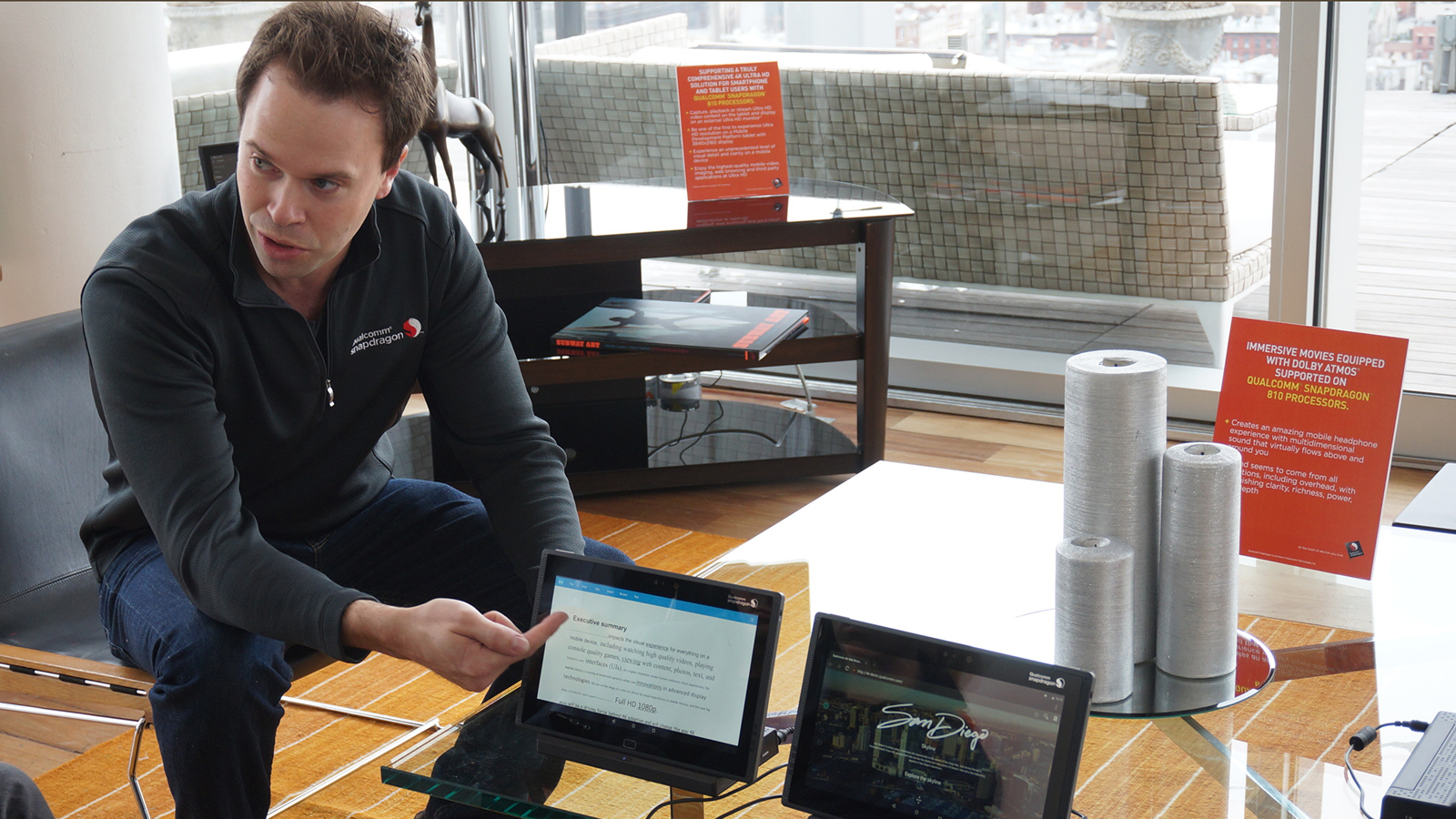How the Snapdragon 810 is going to change smartphones
Qualcomm's big plans for next year's smartphones

Qualcomm showed off its new SoC (system on chip), the Snapdragon 810, to a host of journalists this morning in NYC. Implemented into some reference devices, there were several stations available, each showcasing a new or improved feature made possible with the Snapdragon 810, which will be launching in smartphones by mid 2015.
Starting off with 4K, Qualcomm is focused on putting the capability to natively play, record, and even stream 4K content into the hands of users. But to nip the ever-lurking elephant in the room concerning storing massive 4K files, the Snapdragon 810 will utilize the H.265 video codec, which features compression techniques that can shrink 4K content to a much smaller size.

Although 4K-capable devices like the LG G3, Motorola Droid Turbo and Nexus 6 have been in the hands of the public for the better part of 2014, 4K is still a burgeoning buzzword. But Qualcomm is dead-set on making it a household term in 2015.
To do that, 4K recording will, of course, be natively supported with the 810, as will viewing. But what's new with the 810 is the ability to stream 4K content to a television. Using a proprietary HDMI dongle, users will be able to push content from their phones of tomorrow at 802.11ad speeds (boasting 4-6 gigabit speed). Did you record a stunning time lapse of New York City at night? In 2015, it will be as simple as a tap on the screen to stream 4K in your living room.

4K televisions and 802.11ac wireless routers are still in their infancy in terms of consumer adoption, so what makes Qualcomm so sure that 802.11ad and 4K will be the golden standard by 2015? I can't be the only one who will still be perfectly content rocking 802.11b and 1080p next year.
Sights and sounds
To add to your media-viewing pleasure, the Snapdragon 810 pumps out the Dolby Atmos format, which surrounds you in sound, much like you've heard with with a 5.1 system, but now with new dimensions of audio that seem to come from above and beneath you. Back in November of 2013, we sat down with the sound designer of Gravity, a film that "has Atmos written all over it...". Now, that technology is coming to smartphones. What a time to be alive!

Qualcomm's Snapdragon 810 is also looking to boost the camera experience with support for Corephotonics dual camera technology, which captures two versions of every frame and merges the best qualities of each into one superior frame. It even allows for up to 3x continuous optical zoom with photo stills and up to 5x continuous optical zoom in videos before switching to the inferior digital zoom for closer shots. The goal here is to provide a DSLR-quality in a much smaller form-factor.
Sign up for breaking news, reviews, opinion, top tech deals, and more.
To get the most out of recording with a smartphone, you need a good microphone. And with the Snapdragon 810 in a reference unit equipped with 3 microphones, full-3D sound powered by Fluence Pro is possible. You can even pick and choose the direction from which you want to record.

To illustrate, they brought in a group of carolers. The representative adjusted the audio focus on the fly between him talking off to my left and the carolers singing in front of me.
Gaming performance
They touched briefly on gaming, where with the jump to a 64-bit CPU and the new Adreno 430 integrated GPU, you can expect a 30% performance increase, while using 20% less power. Epic's Unreal Engine runs with added fidelity as illustrated with the newly implemented DoF (depth of field), which looks great. Then, we checked out Skylanders, which also looked good but didn't provoke the same "oo's and ah's" out of us that Epic's engine did.

The hope here is to attract more developers to make scalable, console-quality experiences in a market dominated by casual gamers, which loosely translates to monetization being a juicy, ripe, and low-hanging fruit to pluck.
I was told that phone manufacturers and developers have had their hands on the processor for some time and that they're hard at work integrating the 810 into the phones of tomorrow. Could we see it in the Samsung Galaxy S6, HTC One M9, LG G4 and Sony Xperia Z4? Hopefully. Time will tell, but with our peek at the future, we're ready for mid 2015 to arrive.

Cameron is a writer at The Verge, focused on reviews, deals coverage, and news. He wrote for magazines and websites such as The Verge, TechRadar, Practical Photoshop, Polygon, Eater and Al Bawaba.